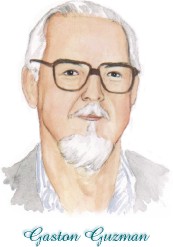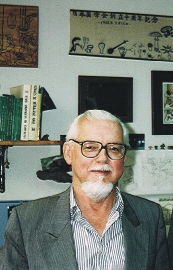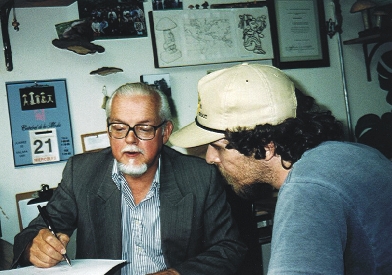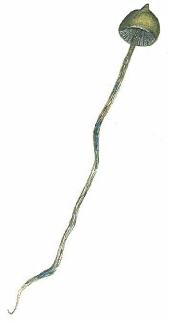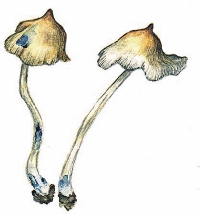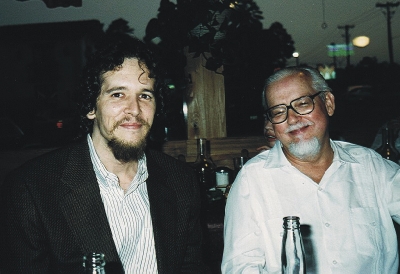Dr. Gaston Guzman -- mycologist, taxonomist, explorer, author and anthropologist -- is the world's foremost authority on the genus Psilocybe, having discovered and authored more than half of the known neurotropic species. He also is a leading authority on the indigenous peoples of Mexico, and their divinatory and medicinal uses of the sacred mushrooms.
Above: Guzman in his office at the Institut de Ecologia, Xalapa, Veracruz, Mexico, August 1996.
Photo by Carol Ann Wells. Courtesy The Stain Blue Museum Collection.
Dr. Guzman was born in Xalapa, Veracruz, in 1932. His interest in mycology began in 1955 while a graduate student at the National Polytechnic Institute, in Mexico City. Up to that point the Institute's collection of fungi had been poorly maintained and he resolved to begin cataloging an entire new collection of specimens. In the summer of that year, Dr. Guzman conducted his first field work in the forests near Mexico City, where he found myriad species about which little was known. This inspired him to declare mushrooms as the topic of his professional thesis and he vowed to someday write a book on Mexican mushrooms.
Above: Psilocybe sanctorum Guzman, a classic teonanacatl species described by Dr. Guzman from the State of Mexico.
Aquarelle by Carol Ann Wells. Courtesy The Stain Blue Museum Collection.
Above: Guzman describing to D. Smith the habitat,
morphology, and distribution of the neurotropic fungi.
Photo by Carol Ann Wells. Courtesy The Stain Blue Museum Collection.
In 1957, Dr. Guzman was invited on an expedition -- led by noted mycologist Dr. Rolf Singer -- to study neurotropic mushrooms in the Huautla de Jimenez region. Dr. Guzman was already familiar with the region, having collected there in 1953 (while in the employ of Syntex Laboratories) medicinal plant specimens belonging to the Dioscorea genus. Dr. Guzman had read with enthusiasm R. Gordon Wasson's Life article published in 1957 and he was delighted to have the opportunity to return to the Huautla region to study the hongos mágico. On the last day of the expedition, Dr. Singer and Guzman met Wasson in a small village near Huautla; Wasson was in the region conducting research and it was from this chance meeting that he and Dr. Guzman formed a close friendship that would last nearly thirty years. This meeting also resulted in Dr. Guzman's later friendship with Wasson's colleagues Roger Heim and Richard Evans Schultes.
In 1958, through his Indian contacts, Dr. Guzman learned of the Aztec word teotlaquilnanacatl. This word is used by the Indians of the Sierra de Puebla region to describe the sacred mushrooms; translated it means "the mushrooms that paint" (referring to the mushrooms' visionary properties). This is noteworthy because the Spanish chronicler Bernardino de Sahagun in 1555 stated that the Aztec name for the sacred mushrooms was teonanacatl. However, it seems that the word teonanacatl is no longer used by the Indians [Guzman, letter to author 1999]. Also in 1958, Dr. Guzman published his first paper on a blue-staining Psilocybe species and the first paper on the ecology of neurotropic fungi. This work was followed by other papers in which he revised the known hallucinogenic species of Mexico and described new habitats and species.
The professional thesis of Dr. Guzman, presented in 1959, fulfilled the requirements for a degree in biology. The subject of the thesis was a study of the known neurotropic fungi of Mexico, their taxonomy, cultural uses, ecology and distribution. The thesis was reviewed by a professional jury and Dr. Guzman was awarded an honorary distinction. Dr. Guzman dedicated his thesis to his teacher Rolf Singer, as well as to Wasson, Heim and Teofilo Herrera, who all aided him in conducting his research.
Above: "Teofilo's Mushroom" (Psilocybe herrerae Guzman).
Described by Dr. Guzman, this caerulescent mushroom was named in honor of Teofilo Herrera,
an outstanding Mexican mycologist, and friend and colleague of Guzman's.
This species is known only from the states of Chiapas and Veracruz, Mexico.
Aquarelle by Carol Ann Wells. Courtesy The Stain Blue Museum Collection
In 1979, Dr. Guzman, along with Stephen H. Pollock, described a new entheogenic mushroom found by them in the Naolinco region of the State of Veracruz. This species was named Psilocybe wassoniorum in honor of Wasson and his wife Valentina.
Above: "Wasson's Psilocybe" (Psilocybe wassoniorum Guzman et Pollock).
Aquarelle by Carol Ann Wells. Courtesy The Stain Blue Museum Collection.
Dr. Guzman's masterpiece, a world monograph titled The Genus Psilocybe: A Systematic Revision of the Known Species Including the History, Distribution and Chemistry of the Hallucinogenic Species, which he began in 1957, was published in 1983 by J. Cramer of Vaduz, Germany. This definitive work was made possible through a grant Dr. Guzman received from The Guggenheim Memorial Foundation of New York, on the recommendation of Richard Evans Schultes.
In 1993, Dr. Guzman, together with mycologists Victor M. Bandala and John W. Allen, described a new neurotropic mushroom, Psilocybe samuiensis, from Koh Samui, Thailand. This is the first blue-staining mushroom reported from Thailand and is the first species of the Section Mexicana to be reported from outside the Americas. Also described by Dr. Guzman were several new bluing species from Australasia: Psilocybe australiana, Psilocybe eucalypta, Psilocybe tasmaniana and Psilocybe aucklandii (the first three in collaboration with the preeminent Scottish mycologist Dr. Roy Watling, the last with Chris King of New Zealand).
From South America, Dr. Guzman described more than ten neurotropic species including Psilocybe brasiliensis, Psilocybe columbiana, Psilocybe meridiensis, Psilocybe antioquiensis and others. From the U.S.A., Dr. Guzman described Psilocybe stuntzii from Washington (in collaboration with Jonathan Ott); Psilocybe tampanensis from Florida (in collaboration with Stephen Pollock); and Psilocybe weilii from Georgia (in collaboration with Fidel Tapia and mycologist Paul Stamets). Currently, Dr. Guzman has several papers in press, describing new species from Mexico, U.S.A., and Spain, as well as a checklist of all the known Psilocybe species in Europe. Also in progress is a book on the worldwide distribution of the neurotropic fungi, in collaboration with John W. Allen and Jochen Gartz.
Above: "Psilocybes Down Under."
Depicted (from left to right) are Psilocybe eucalypta; koala bear (Phascolarctos cinereus); and Psilocybe australiana.
All three species share an affinity for eucalyptus forests in SE Australia.
Aquarelle by Carol Ann Wells. Courtesy The Stain Blue Museum Collection.
In his "Supplement to the monograph of the genus Psilocybe," published in 1995 by J. Cramer, Berlin (and dedicated to Professor Meinhard Moser), Dr. Guzman revised all the species described after his world monograph, and also described several new species and updated the keys for identification of the sections
and species.
Above: Psilocybe angustipleurocystidiata Guzman.
Described by Dr. Guzman from the State of Morelos, Mexico, this mushroom
belongs to the Section Zapotecorum
and is closely related to Psilocybe muliercula.
Aquarelle by Carol Ann Wells. Courtesy The Stain Blue Museum Collection.
Above: Dinner with Dr. Guzman and the author. Lufkin, Texas, September 1996.
Photo by Carol Ann Wells. Courtesy The Stain Blue Museum Collection.
Dr. Guzman's latest book -- Los Nombres de los Hongos y lo relacionado con ellos en America Latina (Names of Mushrooms and Related Things in Latin America) -- was published in Xalapa in 1997. This 356-page dictionary of Latin American mushroom names contains an alphabetical listing of more than 5,500 names based on 1,700+ species, including all the neurotropic Psilocybes. In one of his most recent papers, "Inventorying the fungi of Mexico," Dr. Guzman discussed the knowledge of the diversity of the Mexican fungi. He established that there are more than 200,000 species of fungi, of which only 3.5% are known!
A co-founder and past president of the Mexican Mycology Society, Dr. Guzman resides in Xalapa, Veracruz, Mexico, where he founded the Departamento de Hongos, at the Institut de Ecologia, in Xalapa. During the Third Latin American Congress of Mycology, held at Caracas, Venezuela, Dr. Guzman was elected President of the Latin American Mycological Association for the period 2000-2002. He also is a founding member of the newly formed Panamanian Mycological Society. His daughter Laura Guzman Davalos is a leading mycologist in Mexico, at the Universidad de Guadalajara, at Guadalajara City, where she has headed for the past three years the Institut de Botanica. She has published, in collaboration with her father, several papers on Mexican fungi.
Required Reading
Guzman, G. "El habitat de Psilocybe muliercula Singer & Smith (=Ps. wassonii Heim), agaricaceo alucinogeno mexicano." Revista de la Sociedad Mexicana de Historia Natural 19: 215-229 (1958).
Guzman, G. The Genus Psilocybe: A Systematic Revision of the Known Species Including the History, Distribution and Chemistry of the Hallucinogenic Species. Beihefte zur Nova Hedwigia Heft 74. J. Cramer, Vaduz, Germany (1983) [now out of print].
Guzman, G. "Wasson and the development of Mycology in Mexico." In: Riedlinger, T.J. (Ed.) The Sacred Mushroom Seeker: Essays for R. Gordon Wasson. Ethnomycological Studies No. 11, pp. 83-110. Dioscorides Press, Portland, OR (1990).
Guzman, G. "The Sacred Mushroom in Mesoamerica." In: Miyanishi, T. (Ed.) The Ancient Maya and Hallucinogens, pp. 75-95. Wakayama University, Wakayama, Japan (1992).
Guzman, G. "Supplement to the genus Psilocybe." Bibliotheca Mycologica 159: 91-141 (1995).
Guzman, G. Los Nombres de los Hongos y lo Relacionado con Ellos en America Latina. Instituto de Ecologia, Xalapa, Veracruz, Mexico (1997).
Guzman, G. "Inventorying the fungi of Mexico." Biodiversity and Conservation 7: 365-384 (1997).
Guzman, G. and J. Ott. "Description and chemical analysis of a new species of hallucinogenic Psilocybe from the Pacific Northwest." Mycologia 68: 1261-1267 (1976).
Guzman, G. and S.H. Pollock. "A new bluing species of Psilocybe from Florida." Mycotaxon 7: 373-376 (1978).
Guzman, G. and S.H. Pollock. "Tres nuevas especies y dos nuevos registros de los hongos alucinogenos en Mexico y datos sobre su cultivo en el laboratorio." Bol Soc Mex Mic 13: 261-270 (1979).
Guzman, G., C. King, and V.M. Bandala. "A new species of Psilocybe of section Zapotecorum from New Zealand." Mycological Research 95(4): 507-508 (1991).
Guzman, G., L. Montoya Bello, and V.M. Bandala. "Nuevos registros de los hongos alucinogenos del genero Psilocybe en Mexico y analisis de la distribucion de las especies conocidas." Revista Mexicana de Micologia 4: 255-265 (1988).
Guzman, G., V.M. Bandala, and C. King. "Further observations on the genus Psilocybe from New Zealand." Mycotaxon 46: 161-170 (1993).
Guzman, G., V.M. Bandala, and J.W. Allen. "A new bluing Psilocybe from Thailand." Mycotaxon 46: 155-160 (1993).
Guzman, G. et al. "A new bluing Psilocybe from U.S.A." Mycotaxon 65: 191-196 (1997).
Copyright © 1996-2000 Stain Blue Press
